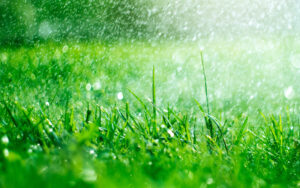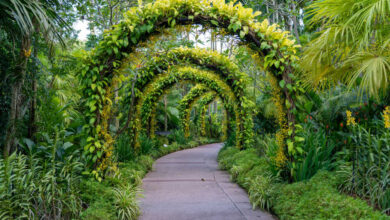Hydroseeding vs. Laying Sod: Which Is Better?

Lawns have a certain appeal that other hard surfaces can’t match. Bright green hues look way better than gray concrete or black asphalt, don’t you think?
When it comes to establishing a new lawn and renovating one, property owners are often confused about whether hydroseeding or laying sod is the better choice. The quick answer will depend on your time, budget, and maintenance requirements.
In this article, we’ll highlight the key differences between having an instant lawn—thanks to sod installation—and growing grass with the help of hydroseeding.

Hydroseeding for a hard-earned lawn
Quality hydroseeding involves evenly mixing fertilizer, seed, nutritious soil, water, mulch—a protective and moisture-rich blanket—and other additives to start your lawn installation. This mixture, called ‘slurry,’ is then sprayed onto the soil to facilitate healthy and thriving grass in your backyard.
What happens next will depend on you. This means you must flex your green thumb or hire an experienced landscaping company to guide you from day one. Like any other planting activity, preparation is paramount to allowing your grass to flourish, as is hard work and proper care.
Laying sod for instant gratification
On the other hand, laying sod is the easier method, as you can purchase sod rolls or slabs from turf farms. Each pallet includes the roots and a thin layer of soil, which are then transported to and installed at the project site.
The good thing about sodding your lawn is that you don’t have to work as hard. However, that’s not to say there’s nothing left to do but sit and watch the grass grow. Before laying sod, you must:
- Request a soil test.
- Remove existing grass or weeds.
- Prep the soil to ensure proper grass growth.
You then have to wait for the sod to take root before enjoying them.
Calling in the experts
No matter which option you choose, seeking expert help is crucial. Hiring hydroseeding and sod installation professionals is crucial if you want to get the best bang for your buck.
Experienced lawn technicians can help you:
- Choose the right type of grass seed or variety for your location
- Request a soil quality analysis
- Prepare the soil for you
- Provide access to the right equipment
- Adjust the project based on your budget
- Offer advice on maintaining your lawn (or offer the services themselves)
Having a vibrant lawn may sound easy, but there’s more to it than meets the eye. Comparing these two grass options requires examining multiple factors to make the best choice.
Hydroseeding vs. laying sod: the rundown
Learning the differences between hydroseeding and laying sod on your lawn could point you in the right direction. You’ll find the most crucial considerations below.
1. Comparing the costs: hydroseeding is generally cheaper
Hydroseeding and sod installation costs differ wildly, depending on several factors. Generally, laying sod is costlier because you’re paying for professionals to tend your pre-grown grass and for installing them later.
Sods are typically sold by pallets, the costs of which differ based on the size and variety. Generally, laying sod would cost a homeowner USD$ 1, 071 to USD$ 3,000. Installation costs run from USD$ 1 to USD$ 2 per square foot, depending on the following considerations: (1)
- Yard size
- Sod type
- Lawn shape
- Preparation requirements (soil testing, old sod removal, fertilization, etc.)
Comparatively, Angi.com estimates that the total material and labor expenses for hydroseeding can run anywhere from USD 500 to USD 4,000, depending on the approach you wish to take.
Professional hydroseeding labor costs are impacted by the following:
- Your lawn and soil conditions
- The type of mixture needed
- Application method and rate
- Your terrain (steeper lawns are more expensive)
DIY hydroseeding can save you further. Tackling the project yourself requires renting a hydroseeder and purchasing hydroseeding kits, or a hydroseed mix, which can run a few hundred dollars.
2. Time requirements: laying sod yields faster results
Besides costs, time is another primary consideration when determining the best grass installation option. Compared to sodding grass, hydroseeding takes longer to establish a usable lawn.
Most homeowners wait up to two months to fully enjoy their green hydroseeded lawn while turf-laying clients can enjoy their lawn within a few weeks after installation. If you’re pressed for time and need to create your dream garden the soonest, laying sod is the better option.
3. Seed choice and customization: hydroseeding provides more variety
About 50 different types of turfgrass species exist in the country—primarily categorized as cold and warm-season. As their names imply, cold-season grass grows better in colder regions. At the same time, warm-season turfgrass is more resistant to the dry season. Some species are more suited to residential use. In contrast, others thrive better in commercial environments—for instance, parks or golf courses. (2) (3)
Hydroseeding offers wider flexibility in seed selection. Hence, it can be used for various grass types, and you can mix multiple species based on your preference. That’s because each slurry can be tailored to meet your specific needs, depending on the amount of sunlight your lawn needs and the type of soil in your location. Besides establishing a healthy and fast-growing lawn, hydroseeding can be used in other plant species.
Unfortunately, this won’t work with laying sod. This lawn installation option allows you to plant the same variety throughout your yard. Thus, choosing the right grass species is key.
4. Other conditions: Hydroseeding has a slight edge
Besides sod and hydroseeding costs, time requirements, and seed variety choices, your comparison should also include other factors, such as:
1. Lawn size and topography
Hydroseeding is more cost-effective if you have a large area with hard-to-reach or irregularly shaped sections. For example, laying sod on uneven soil needs additional work, and the cost of old turf removal could add between USD$ 1 and USD$ 3 per square foot to your installation bill. (4)
It’s also better if your yard is uneven, steep, and prone to erosion. Mulching, an important component of hydroseeding, can reduce soil loss by 76.2% and water runoffs by 47.4%, according to a 2023 global study. Organic mulch materials provide a protective blanket, making the ground more stable while retaining moisture and controlling temperature. (5)
2. Climate and weather conditions
As mentioned, some turfgrass varieties are more resistant to certain temperatures. However, all these species require water to thrive—with new hydroseed grass needing up to three times more. If you don’t have an irrigation system or live in an extremely hot place, your success with hydroseeding might be compromised.
5. Maintenance and care: tie
The health of your newly installed grass lawn depends on how you care for it. Having grass companies onboard provides you with valuable care and maintenance tips. Let’s explore how each option fares based on different factors:
a. Watering requirements
Your hydroseeded lawn needs intensive watering for proper seed germination and even growth. It’s common for your lawn technician to ask you to water it two to three times daily in the early stages. Sod doesn’t require as much water as hydroseeding, however.
b. Fertilizing and mowing
Providing your newly installed grass with extra nutrients is key to a vibrant and healthy lawn. Hydroseeded sites will require fertilizer application around three weeks after installation. Ask your service provider for instructions on how to avoid fertilizer burns and other mistakes. Sod, however, demands one shortly after being transplanted.
Shorter waiting times also apply when mowing a sod. This grass takes less than a month to take root, and you can cut it within a month after installation. Conversely, it takes around two months for your newly-hydroseeded lawn to be safe for mowing.
c. Weed control
Weeds may appear on your freshly-installed sod if your land prep was sloppy. On the other hand, hydroseeding prevents weed growth better than laying a sod. That’s because mulch can effectively keep unwanted weeds away besides keeping moisture and preventing soil erosion.
The wrap-up
Hydroseeding and laying sod are two great options for establishing a thriving and vibrant landscape. Each has its pros and cons. Choosing the better option means analyzing their differences and aligning them with your priorities and preferences.
For instance, hydroseeding is cost-effective and great for erosion control. On the downside, it takes longer and requires more water and care than laying turf. However, if cost isn’t an issue in your quest for an instantly usable and lush lawn, then installing sod might be a better option.
If you still need help deciding or have complex requirements, it’s best to call a reputable lawn care company near you for advice. Whichever you choose, you’re already a winner just by working with the experts.
References
- Kasch, Alison. ‘Sod Prices: The True Cost of Sod Installation (2024 Data)’. January 24, 2024. Accessed online.
https://www.angi.com/articles/how-much-does-it-cost-lay-sod.htm#:~:text=Sod%20prices%20typically%20range%20between%20%241%2C071%20and%20%243%2C000%20with%20an%20average%20cost%20of%20%242%2C026.%20You%E2%80%99ll%20pay%20between%20%240.35%20to%20%240.85%20per%20square%20foot%20for%20the%20materials%20and%20anywhere%20from%20%241%20to%20%242%20per%20square%20foot%20for%20sod%20installation
- Stackhouse, Tammy, et al. ‘Turfgrass Disease Diagnosis: Past, Present, and Future’. November 11, 2020. Accessed online.
https://www.ncbi.nlm.nih.gov/pmc/articles/PMC7697262/#:~:text=There%20are%20several%20factors%20that%20make%20diagnosing%20diseases%20in%20turfgrass%20difficult.%20Plants%20grown%20as%20%E2%80%9Cturfgrass%E2%80%9D%20encompass%20about%2050%20different%20species%20of%20grasses%2C%20each%20with%20their%20own%20varieties%20and%20growth%20requirements
- US Environmental Protection Agency. ‘Turfgrass and Water efficiency’. June 8, 2023. Accessed online.
https://www.epa.gov/watersense/turfgrass-and-water-efficiency
- Kasch, Alison. ‘Sod Prices: The True Cost of Sod Installation (2024 Data)’. January 24, 2024. Accessed online.
https://www.angi.com/articles/how-much-does-it-cost-lay-sod.htm#:~:text=If%20your%20yard%20is%20in%20poor%20condition%20for%20laying%20sod%2C%20then%20you%E2%80%99ll%20want%20to%20factor%20in%20the%20price%20to%20remove%20the%20old%20sod%20and%20prepare%20the%20ground%20for%20the%20new%20sod.%20You%20can%20rent%20a%20sod%2Dcutter%20for%20around%20%2480%20per%20day%20or%20hire%20a%20pro%20to%20remove%20old%20grass%20for%20anywhere%20between%20%241%20and%20%243%20per%20square%20foot.%C2%A0
- Fan, Dengxing, et al. ‘The effectiveness of mulching practices on soil erosion control: A global meta-analysis’. October 2023. Accessed online.
https://www.sciencedirect.com/science/article/pii/S0016706123003208#:~:text=On%20average%2C%20mulching%20practice%20reduced%20runoff%20by%2047.4%25%20and%20soil%20loss%20by%2076.2%25.




